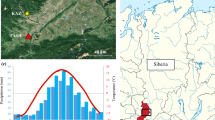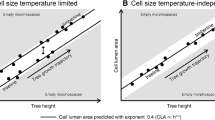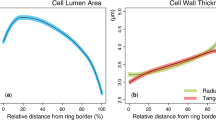Abstract
The warming-driven increase of the vegetation season length impacts both net productivity and phenology of plants, changing an annual carbon cycle of terrestrial ecosystems. To evaluate this influence, tree growth along the temperature gradients can be investigated on various organization levels, beginning from detailed climatic records in xylem cells’ number and morphometric parameters. In this study, the Borus Ridge of the Western Sayan Mountains (South Siberia) was considered as a forest area under rapid climate change caused by massive Sayano-Shushenskoe reservoir. Several parameters of the xylem anatomical structure in Siberian spruce (Picea obovata Ledeb.) were derived from normalized tracheidograms of cell radial diameter and cell wall thickness and analyzed during 50 years across elevational gradient (at 520, 960, and 1320 m a.s.l.). On the regional scale, the main warming by 0.42°C per decade occurs during cold period (November–March). Construction of the reservoir accelerated local warming substantially since 1980, when abrupt shift of the cold season temperature by 2.6°C occurred. It led to the vegetation season beginning 3–6 days earlier and ending 4–10 day later with more stable summer heat supply. Two spatial patterns were found in climatic response of maximal cell wall thickness: (1) temperature has maximal impact during 21-day period, and its seasonality shifts with elevation in tune with temperature gradient; (2) response to the date of temperature passing +9.5°C threshold is observed at two higher sites. Climate change yielded significantly bigger early wood spruce tracheids at all sites, but its impact on cell wall deposition process had elevational gradient: maximal wall thickness increased by 7.9% at the treeline, by 18.2% mid-range, and decreased by 4.9% at the lower boundary of spruce growth; normalized total cell wall area increased by 6.2%–6.8% at two higher sites but remained stable at the lowest one. We believe that these patterns are caused by two mechanisms of spruce secondary growth cessation: “emergency” induced by temperature drop versus “regular” one in warmer conditions. Therefore, autumn lengthening of growth season stimulated wood matter accumulation in tracheid walls mainly in cold environment, increasing role of boreal and mountain forests in carbon cycle.
Similar content being viewed by others
References
Anfodillo T, Carraro V, Carrer M, et al. (2006) Convergent tapering of xylem conduits in different woody species. New Phytologist 169(2): 279–290. https://doi.org/10.1111/j.1469-8137.2005.01587.x
Arzac A, Babushkina EA, Fonti P, et al. (2018) Evidences of wider latewood in Pinussylvestris from a forest-steppe of Southern Siberia. Dendrochronologia 49: 1–8. https://doi.org/10.1016/j.dendro.2018.02.007
Babushkina E, Belokopytova L, Zhirnova D, et al. (2018a) Divergent growth trends and climatic response of Picea obovata along elevational gradient in Western Sayanmountains, Siberia. Journal of Mountain Science 15(11): 2378–2397. https://doi.org/10.1007/s11629-018-4974-6
Babushkina EA, Belokopytova LV, Zhirnova DF, et al. (2018b) Climatically driven yield variability of major crops in Khakassia (South Siberia). International Journal of Biometeorology 62(6): 939–948. https://doi.org/10.1007/s00484-017-1496-9
Babushkina EA, Belokopytova LV, Zhirnova DF, Vaganov EA (2019) Siberian spruce tree ring anatomy: imprint of development processes and their high-temporal environmental regulation. Dendrochronologia 53: 114–124. https://doi.org/10.1016/j.dendro.2018.12.003
Badeck FW, Bondeau A, Bottcher K, et al. (2004) Responses of spring phenology to climate change. New Phytologist 162: 295–309. https://doi.org/10.1111/j.1469-8137.2004.01059.x
Belokopytova LV, Babushkina EA, Zhirnova DF, et al. (2018) Climatic response of conifer radial growth in forest-steppes of South Siberia: comparison of three approaches. Contemporary Problems of Ecology 11(4): 366–376. https://doi.org/10.1134/S1995425518040030
Belokopytova LV, Babushkina EA, Zhirnova DF, et al. (2019) Pine and larch tracheids capture seasonal variations of climatic signal at moisture-limited sites. Trees 33(1): 227–242. https://doi.org/10.1007/s00468-018-1772-2
Case BS, Duncan RP (2014) A novel framework for disentangling the scale-dependent influences of abiotic factors on alpine treeline position. Ecography 37(9): 838–851. https://doi.org/10.1111/ecog.00280
Carrer M, von Arx G, Castagneri D, Petit G (2015) Distilling allometric and environmental information from time series of conduit size: the standardization issue and its relationship to tree hydraulic architecture. Tree Physiology 35(1): 27–33. https://doi.org/10.1093/treephys/tpu108
Carrer M, Castagneri D, Prendin AL, et al. (2017) Retrospective analysis of wood anatomical traits reveals a recent extension in tree cambial activity in two high-elevation conifers. Frontiers in Plant Science 8: 737. https://doi.org/10.3389/fpls.2017.00737
Castagneri D, Battipaglia G, von Arx G, et al. (2018) Tree-ring anatomy and carbon isotope ratio show both direct and legacy effects of climate on bimodal xylem formation in Pinus pinea. Tree Physiology 38(8): 1098–1109. https://doi.org/10.1093/treephys/tpy036
Chae H, Lee H, Lee S, et al. (2012) Local variability in temperature, humidity and radiation in the BaekduDaegan Mountain protected area of Korea. Journal of Mountain Science 9(5): 613–627. https://doi.org/10.1007/s11629-012-2347-0
Chave J, Coomes D, Jansen S, et al. (2009) Towards a worldwide wood economics spectrum. Ecology Letters 12(4): 351–366. https://doi.org/10.1111/j.1461-0248.2009.01285.x
Christidis N, Stott PA, Brown S, et al. (2007) Human contribution to the lengthening of the growing season during 1950–99. Journal of Climate 20(21): 5441–5454. https://doi.org/10.1175/2007JCLI1568.1
Churkina G, Schimel D, Braswell BH, Xiao X (2005) Spatial analysis of growing season length control over net ecosystem exchange. Global Change Biology 11(10): 1777–1787. https://doi.org/10.1111/j.1365-2486.2005.001012.x
Cook ER, Kairiukstis LA (eds.) (1990) Methods of Dendrochronology. Application in Environmental Sciences. Dordrecht, Boston, London: Kluwer Academic Publishers. p 394.
Cooke JE, Eriksson ME, Junttila O (2012) The dynamic nature of bud dormancy in trees: environmental control and molecular mechanisms. Plant, Cell & Environment 35(10): 1707–1728. https://doi.org/10.1111/j.1365-3040.2012.02552.x
Cuny HE, Rathgeber CB, Frank D, et al. (2015) Woody biomass production lags stem-girth increase by over one month in coniferous forests. Nature Plants 1(11): 15160. https://doi.org/10.1038/nplants.2015.160
Davi H, Dufrêne E, Francois C, et al. (2006) Sensitivity of water and carbon fluxes to climate changes from 1960 to 2100 in European forest ecosystems. Agricultural and Forest Meteorology 141(1): 35–56. https://doi.org/10.1016/j.agrformet.2006.09.003
Demina AV, Belokopytova LV, Andreev SG, et al. (2017) Radial increment dynamics of Scots pine (Pinus sylvestris L.) as an indicator of hydrothermal regime of the Western Transbaikalia forest steppe. Contemporary Problems of Ecology 10(5): 476–487. https://doi.org/10.1134/S1995425517050031
Deslauriers A, Fonti P, Rossi S, et al. (2017) Ecophysiology and plasticity of wood and phloem formation. In: Amoroso M, et al. (eds.), Dendroecology. Tree-Ring Analyses Applied to Ecological Studies. Springer, Cham. pp 13–33. https://doi.org/10.1007/978-3-319-61669-8_2
Eilmann B, Zweifel R, Buchmann N, et al. (2009) Drought-induced adaptation of the xylem in Scots pine and pubescent oak. Tree Physiology 29(8): 1011–1020. https://doi.org/10.1093/treephys/tpp035
Filion L, Payette S, Gauthier L, Boutin Y (1986) Light rings in subarctic conifers as a dendrochronological tool. Quaternary Research 26(2): 272–279. https://doi.org/10.1016/0033-5894(86)90111-0
Fonti P, von Arx G, García-González I, et al. (2010) Studying global change through investigation of the plastic responses of xylem anatomy in tree rings. New Phytologist 185(1): 42–53. https://doi.org/10.1111/j.1469-8137.2009.03030.x
Frich P, Alexander LV, Della-Marta PM, et al. (2002) Observed coherent changes in climatic extremes during the second half of the twentieth century. Climate Research 19(3): 193–212. https://doi.org/10.3354/cr019193
Fritts HC (1976) Tree Rings and Climate. London: Academic Press. p 582.
Fritts HC, Swetnam TW (1989) Dendroecology: a tool for evaluating variations in past and present forest environments. Advances in Ecological Research 19: 111–188. https://doi.org/10.1016/S0065-2504(08)60158-0
Gričar J, Prislan P, de Luis M, et al. (2015) Plasticity in variation of xylem and phloem cell characteristics of Norway spruce under different local conditions. Frontiers in Plant Science 6: 730. https://doi.org/10.3389/fpls.2015.00730
Hamlet AF, Lettenmaier DP (2005) Production of temporally consistent gridded precipitation and temperature fields for the continental United States. Journal of Hydrometeorology 6(3): 330–336. https://doi.org/10.1175/JHM420.1
Hänninen H, Tanino K (2011) Tree seasonality in a warming climate. Trends in Plant Science 16(8): 412–416. https://doi.org/10.1016/j.tplants.2011.05.001
Keeling CD, Chin JFS, Whorf TP (1996) Increased activity of northern vegetation inferred from atmospheric CO2 measurements. Nature 382: 146–149. https://doi.org/10.1038/382146a0
Keenan TF, Gray J, Friedl MA, et al. (2014) Net carbon uptake has increased through warming-induced changes in temperate forest phenology. Nature Climate Change 4(7): 598. https://doi.org/10.1038/NCLIMATE2253
Kilpeläinen A, Peltola H, Ryyppö A, et al. (2003) Wood properties of Scots pines (Pinus sylvestris) grown at elevated temperature and carbon dioxide concentration. Tree Physiology 23(13): 889–897. https://doi.org/10.1093/treephys/23.13.889
Körner C, Basier D (2010) Phenology under global warming. Science 327(5972): 1461–1462. https://doi.org/10.1126/science.1186473
Kosmakov IV (2001) Thermal and Ice Regime in the Upper and Lower Reaches of High-Pressure Hydroelectric Power Stations on the Yenisei. Krasnoyarsk: Klaretianum. p 142. (In Russian)
Lachenbruch B, Moore JR, Evans R. (2011) Radial variation in wood structure and function in woody plants, and hypotheses for its occurrence. In: Meinzer FC, et al. (eds.), Size- and Age-Related Changes in Tree Structure and Function. Dordrecht: Springer. pp 121–164. https://doi.org/10.1007/978-94-007-1242-3_5
Larson PR (1994) The Vascular Cambium. Development and Structure. Berlin, Heidelberg: Springer-Verlag. p 725.
Lei H, Milota MR, Gartner BL (1996) Between- and within-tree variation in the anatomy and specific gravity of wood in Oregon white oak (Quercus garryana Dougl.). IAWA Journal 17(4): 445–461. https://doi.org/10.1163/22941932-90000642
Leuzinger S, Luo Y, Beier C, et al. (2011) Do global change experiments overestimate impacts on terrestrial ecosystems?. Trends in Ecology & Evolution 26(5): 236–241. https://doi.org/10.1016/j.tree.2011.02.011
Ma Q, Huang JG, Hänninen H, Berninger F (2018) Reduced geographical variability in spring phenology of temperate trees with recent warming. Agricultural and Forest Meteorology 256: 526–533. https://doi.org/10.1016/j.agrformet.2018.04.012
Malanson GP (2017) Mixed signals in trends of variance in high-elevation tree ring chronologies. Journal of Mountain Science 14(10): 1961–1968. https://doi.org/10.1007/s11629-017-4425-9
Maurer EP, Wood AW, Adam JC, et al. (2002) A long-term hydrologically based dataset of land surface fluxes and states for the conterminous United States. Journal of Climate 15(22): 3237–3251. https://doi.org/10.1175/1520-0442(2002)015<3237:ALTHBD>2.0.CO;2
Mencuccini M, Hölttä T, Petit G, Magnani F (2007) Sanio’s laws revisited. Size dependent changes in the xylem architecture of trees. Ecology Letters 10(11): 1084–1093. https://doi.org/10.1111/j.1461-0248.2007.01104.x
Menzel A (2000) Trends in phenological phases in Europe between 1951 and 1996. International Journal of Biometeorology 44(2): 76–81. https://doi.org/10.1007/s004840000054
Panyushkina IP, Hughes MK, Vaganov EA, Munro MA (2003) Summer temperature in northeastern Siberia since 1642 reconstructed from tracheid dimensions and cell numbers of Larix cajanderi. Canadian Journal of Forest Research 33(10): 1905–1914. https://doi.org/10.1139/x03-109
Pedlar JH, McKenney DW, Lawrence K, et al. (2015) A comparison of two approaches for generating spatial models of growing-season variables for Canada. Journal of Applied Meteorology and Climatology 54(2): 506–518. https://doi.org/10.1175/JAMC-D-14-0045.1
Peltola H, Kilpeläinen A, Kellomäki S (2002) Diameter growth of Scots pine (Pinus sylvestris) trees grown at elevated temperature and carbon dioxide concentration under boreal conditions. Tree Physiology 22(14): 963–972. https://doi.org/10.1093/treephys/22.14.963
Peñuelas J, Filella I (2009) Phenology feedbacks on climate change. Science 324(5929): 887–888. https://doi.org/10.1126/science.1173004
Piao S, Ciais P, Friedlingstein P, et al. (2008) Net carbon dioxide losses of northern ecosystems in response to autumn warming. Nature 451(7174): 49–52. https://doi.org/10.1038/nature06444
Polikarpov NP, Nazimova DI (1963) The dark coniferous forests of the northern part of the west Siberian mountains. In: Forestry Research in the Forests of Siberia. Krasnoyarsk: Institute for Forests and Wood. Vol. 57. pp 103–147. (In Russian)
Plomion C, Leprovost G, Stokes A (2001) Wood formation in trees. Plant Physiology 127(4): 1513–1523. https://doi.org/10.1104/pp.010816
Popov AV, Shatravskii AI (1994) Removal of floating timber from the Sayano-Shushenskoe hydrostation reservoir. Hydrotechnical Construction 28(4): 204–208. https://doi.org/10.1007/BF01545054
Price MF, Byers AC, Friend DA, et al. (eds.) (2013) Mountain Geography: Physical and Human Dimensions. Berkeley: University of California Press. p 378.
Ren P, Rossi S, Gricar J, et al. (2015) Is precipitation a trigger for the onset of xylogenesis in Juniperus przewalskii on the north-eastern Tibetan Plateau? Annals of Botany 115(4): 629–639. https://doi.org/10.1093/aob/mcu259
Ren P, Rossi S, Camarero JJ, et al. (2018) Critical temperature and precipitation thresholds for the onset of xylogenesis of Juniperus przewalskii in a semi-arid area of the northeastern Tibetan Plateau. Annals of Botany 121(4): 617–624. https://doi.org/10.1093/aob/mcx188
Root TL, Price JT, Hall KR, et al. (2003) Fingerprints of global warming on wild animals and plants. Nature 421: 57–60. https://doi.org/10.1038/nature01333
Rosell JA, Olson ME, Anfodillo T (2017) Scaling of xylem vessel diameter with plant size: causes, predictions, and outstanding questions. Current Forestry Reports 3(1): 46–59. https://doi.org/10.1007/s40725-017-0049-0
Rosgidromet (2010) Guidelines for the Compilation of Agrometeorological Yearbook for the Agricultural Zone of the Russian Federation (Guiding Document 52.33.725-2010).Obninsk: Russian Scientific Research Institute of Hydrometeorological Information, World Data Center. p 142. (In Russian)
Rossi S, Deslauriers A, Griçar J, et al. (2008) Critical temperatures for xylogenesis in conifers of cold climates. Global Ecology and Biogeography 17(6): 696–707. https://doi.org/10.1111/j.1466-8238.2008.00417.x
Rossi S, Rathgeber CB, Deslauriers A (2009) Comparing needle and shoot phenology with xylem development on three conifer species in Italy. Annals of Forest Science 66(2): 1–8. https://doi.org/10.1051/forest/2008088
Rossi S, Anfodillo T, Čufar K, et al. (2013) A meta-analysis of cambium phenology and growth: linear and non-linear patterns in conifers of the northern hemisphere. Annals of Botany 112(9): 1911–1920. https://doi.org/10.1093/aob/mct243
Schickhoff U, Bobrowski M, Böhner J, et al. (2015) Do Himalayan treelines respond to recent climate change? An evaluation of sensitivity indicators. Earth System Dynamics 6: 245–265. https://doi.org/10.5194/esd-6-245-2015
Schweingruber FH (1988) Tree Rings: Basics and Applications of Dendrochronology. Dordrecht: Springer. p 276. https://doi.org/10.1007/978-94-009-1273-1
Schweingruber FH (2006) Anatomical characteristics and ecological trends in the xylem and phloem of Brassicaceae and Resedacae. Iawa Journal 27(4): 419–442. https://doi.org/10.1163/22941932-90000164
Seo JW, Smiljanić M, Wilmking M (2014) Optimizing cell-anatomical chronologies of Scots pine by stepwise increasing the number of radial tracheid rows included — Case study based on three Scandinavian sites. Dendrochronologia 32(3): 205–209. https://doi.org/10.1016/j.dendro.2014.02.002
Silkin PP (2010) Methods of Multiparameter Analysis of Conifers Tree-Rings Structure. Krasnoyarsk: Siberian Federal University. p 335. (In Russian)
Skomarkova MV, Vaganov EA, Mund M, et al. (2006) Inter-annual and seasonal variability of radial growth, wood density and carbon isotope ratios in tree rings of beech (Fagus sylvatica) growing in Germany and Italy. Trees 20(5): 571–586. https://doi.org/10.1007/s00468-006-0072-4
Stamm AJ (1929) Density of wood substance, adsorption by wood, and permeability of wood. The Journal of Physical Chemistry 33(3): 398–414.
Stinziano JR, Way DA (2014) Combined effects of rising [CO2] and temperature on boreal forests: growth, physiology and limitations. Botany 92(6): 425–436. https://doi.org/10.1139/cjb-2013-0314
Taeger S, Sparks TH, Menzel A (2015) Effects of temperature and drought manipulations on seedlings of Scots pine provenances. Plant Biology 17(2): 361–372. https://doi.org/10.1111/plb.12245
Tanino KK, Kalcsits L, Silim S, et al. (2010) Temperature-driven plasticity in growth cessation and dormancy development in deciduous woody plants: a working hypothesis suggesting how molecular and cellular function is affected by temperature during dormancy induction. Plant Molecular Biology 73(1–2): 49–65. https://doi.org/10.1007/s11103-010-9610-y
Vaganov EA, Shashkin AV, Sviderskaya LV, Vysotskaya LG (1985) Histometric Analysis of Woody Plant Growth. Novosibirsk: Nauka. p 102. (In Russian)
Vaganov EA, Hughes MK, Shashkin AV (2006) Growth Dynamics of Conifer Tree Rings: Images of Past and Future Environments. Berlin, Heidelberg: Springer-Verlag. p 358.
Vysotskaya LG, Vaganov EA (1989) Components of the variability of radial cell size in tree rings of conifers. IAWA Journal 10(4): 417–426. https://doi.org/10.1163/22941932-90001134
Wang X, Gao Q, Wang C, Yu M (2017) Spatiotemporal patterns of vegetation phenology change and relationships with climate in the two transects of East China. Global Ecology and Conservation 10: 206–219. https://doi.org/10.1016/j.gecco.2017.01.010
Wieser G, Holtmeier FK, Smith WK (2014) Treelines in a changing global environment. In: Tausz M, Grulke N (eds.), Trees in a Changing Environment. Springer, Dordrecht, The Netherlands. pp 221–263. https://doi.org/10.1007/978-94-017-9100-7
Wolkovich EM, Cook BI, Allen JM, et al. (2012) Warming experiments under predict plant phenological responses to climate change. Nature 485: 494–497. https://doi.org/10.1038/nature11014
Wypych A, Ustrnul Z, Schmatz DR (2018) Long-term variability of air temperature and precipitation conditions in the Polish Carpathians. Journal of Mountain Science 15(2): 237–253. https://doi.org/10.1007/s11629-017-4374-3
Ziaco E, Biondi F (2016) Tree growth, cambial phenology, and wood anatomy of limber pine at a Great Basin (USA) mountain observatory. Trees 30(5): 1507–1521. https://doi.org/10.1007/s00468-016-1384-7
Ziaco E, Truettner C, Biondi F, Bullock S (2018) Moisture-driven xylogenesis in Pinus ponderosa from a Mojave Desert mountain reveals high phenological plasticity. Plant, Cell & Environment 41(4): 823–836. https://doi.org/10.1111/pce.13152
Zobel BJ, Sprague JR (1998) Juvenile Wood in Forest Trees. Berlin: Springer. p 300.
Acknowledgements
Authors would like to thank administration of the National Park “ShushenskyBor” and personally its director Tolmachev V.A. for providing permission and facilitating field work on the park territory. The research reported in this manuscript is funded by the Russian Foundation for Basic Research (Project No. 17-04-00315, data aquisition and wood anatomy analysis) and Russian Science Foundation (Project No 19-18-00145, analysis of climate change and its impact).
Author information
Authors and Affiliations
Corresponding author
Electronic supplementary material
Rights and permissions
About this article
Cite this article
Babushkina, E., Zhirnova, D., Belokopytova, L. et al. Warming induced changes in wood matter accumulation in tracheid walls of spruce. J. Mt. Sci. 17, 16–30 (2020). https://doi.org/10.1007/s11629-019-5516-6
Received:
Revised:
Accepted:
Published:
Issue Date:
DOI: https://doi.org/10.1007/s11629-019-5516-6




